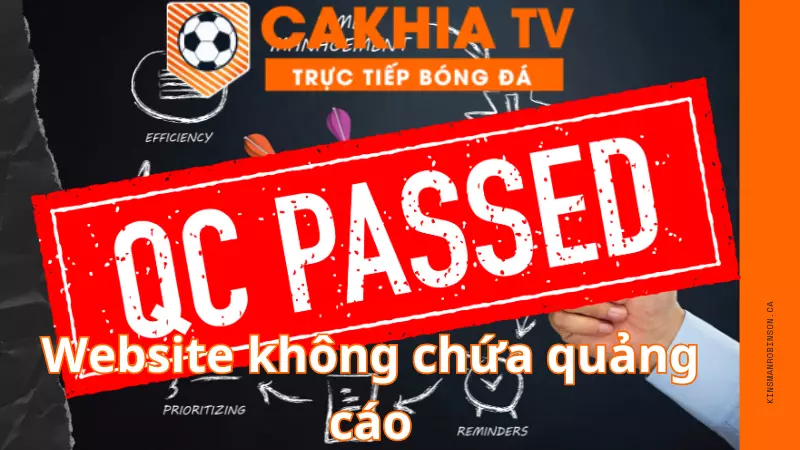Cakhia TV |Xem trực tiếp bóng đá siêu mượt tại cakhiatv link
Hầu hết những anh em đam mê bóng đá đều thường xuyên truy cập Cakhiatv để theo dõi trực tiếp bóng đá và tin tức bóng đá nhanh nhất. Trước khi truy cập vào kinsmanrobinson.ca này thì bạn nên xem qua các thông tin chi tiết sau đây. Bạn có thể hiểu rõ hơn về các tính năng mà trang web mang đến cho người dùng.
CakhiaTV xem bóng đá trực tuyến là gì?

CakhiaTV là một địa điểm hàng đầu cho việc xem trực tiếp bóng đá ở khu vực châu Á. Với chất lượng HD và dàn bình luận viên chuyên nghiệp như Giàng A Phò, Giàng A Lử, trang web này mang đến trải nghiệm sống động cho người hâm mộ.
Cakhia TV thu hút đông đảo người xem với hệ thống biên tập viên và chuyên gia hàng đầu, cung cấp thông tin bóng đá chính xác và đầy đủ. Đặc biệt, với đầu tư vào kinsmanrobinson.ca chất lượng full HD và công nghệ phát sóng hiện đại như đường truyền P2P, CakhiaTV đảm bảo mọi trận đấu được truyền tải mượt mà và ổn định.
Đội ngũ BLV chuyên nghiệp thường xuyên xuất hiện trong các trận đấu lớn, tạo thêm phần sinh động và thú vị cho người xem bóng đá. CakhiaTV đã nhanh chóng trở thành lựa chọn hàng đầu cho những người yêu thể thao, thu hút hàng nghìn lượt truy cập mỗi ngày.
Mục tiêu phát triển của website trực tiếp bóng đá Cakhiatv link

Kể từ khi được thành lập Cakhiatv đã đặt mục tiêu trở thành website phát sóng bóng đá trực tiếp hàng đầu tại châu Á. Đơn vị đầu tư rất nhiều tiền và công sức nhằm có thể xây dựng được một trang web thể thao hoàn chỉnh nhất. Bạn có thể trải nghiệm các trận đấu hay nhất hiện nay.
Trong quá trình hoạt động thì Cakhiatv đã có những thành tựu ban đầu đáng nể trên thị trường bóng đá trực tuyến. Khi kinsmanrobinson.ca cakhia 6.link trở thành địa điểm quen thuộc của rất nhiều người thì đơn vị bắt đầu cho ra mắt phiên bản tải về trên điện thoại và máy tính. Lúc này bạn có thể chọn xem trên điện thoại hoặc trên máy tính thông qua hình thức tải ứng dụng khá đơn giản.
Với sự đầu tư, cố gắng của đội ngũ nhân viên kỹ thuật Cakhiatv đã giúp cho trang web ngày càng phát triển hơn nữa. Chắc chắn trong tương lai gần thì đơn vị sẽ trở thành một link phát trực tiếp bóng đá và cung cấp thông tin thể thao hàng đầu trên thế giới. Trang web đang là nơi mà tất cả những anh em thích xem bóng đá đều biết đến.
| ✅ Website chính thức | Cakhiatv |
| ✅ Kênh trực tiếp bóng đá | Được yêu thích nhất |
| ✅ Bình luận tiếng Việt | Miễn phí |
| ✅ Phát sóng | Tất cả các trận đấu |
Những tính năng nổi bật có mặt tại Cakhiatv 6.link

Theo như khảo sát thực tế thông qua những người đã từng xem tructiepbongda tại Cakhiatv thì họ đều để lại bình luận cực kỳ hài lòng với những tính năng mà kinsmanrobinson.ca cung cấp. Tại đây bạn không chỉ được xem trực tiếp trận đấu bóng đá với chất lượng cao nhất. Mà bạn còn có thể cập nhật thêm nhiều tính năng mới liên quan đến thể thao, cụ thể là:
- Link trực tiếp bóng đá: cakhiatv link trực tiếp bóng đá giúp bạn xem trực tiếp những trận bóng đá đỉnh cao với 1 cách dễ dàng và tiền lợi. Bạn sẽ tận những khoản khác, tình huống và cú sút trên sân cỏ một cách chân thật như trên khán đài.
- Tin tức bóng đá: Cakhiatv luôn chủ động tìm kiếm và cập nhật toàn bộ các thông tin bóng đá mới nhất trong nước và các trận đấu thế giới. Nhờ vào những thông tin này mà bạn có thể biết được tin tức về cầu thủ, huấn luyện viên, trước trận đấu, giải đấu, chuyển nhượng,.. một cách chính xác và nhanh chóng nhất.
- Lịch thi đấu bóng dá: Cakhiatv hiện tại đang cung cấp thêm cho người xem lịch thi đấu cho toàn bộ các giải bóng đá trên thế giới và trong nước. Nhờ vào những thông tin này bạn có thể nắm được ngày giờ diễn ra các trận đấu hấp dẫn hay các đội bóng dễ dàng.
- Bảng xếp hạng: Khi bạn truy cập vào Cakhiatv sẽ được tham khảo bảng xếp hạng ở bất kỳ giải đấu bóng đá nào mà bạn yêu thích. Bạn có thể nắm bắt được thành tích các đội bóng trên bảng xếp hạng liên quan đến quá trình soi kèo hiệu quả.
- Kết quả bóng đá: Cakhiatv còn nhanh chóng cập nhật kết quả toàn bộ các trận đấu bóng đá vừa diễn ra được nhiều người quan tâm. Để bạn biết được tỉ số những trận đấu mà mà bạn đã bỏ lỡ.
- Highlight: Với chức năng này tại Cakhiatv bạn có thể theo dõi các video highlight các trận đấu bóng đá lớn vừa mới diễn ra. Thông qua các video này mà bạn có thể nhận định diễn biến của trận đấu như thế nào, cầu thủ ghi bàn ra sao, các tình huống hấp dẫn,… mà không mất thời gian.
- Tỷ lệ kèo: Đối với những người tham gia cược bóng đá thì bạn có thể tham khảo bảng kèo của toàn bộ các trận đấu bóng đá. Đặc biệt là những trận đấu chuẩn bị diễn ra với đầy đủ thông tin soi kèo chuẩn nhất. Điều này sẽ giúp bạn soi kèo bất kỳ trận đấu bóng đá nào mà bạn muốn vô cùng dễ dàng.
- Tips: Chức năng này của Cakhiatv được rất nhiều người quan tâm vì nó giúp bạn tham khảo được những kinh nghiệm soi kèo, bí quyết cá cược bóng đá từ nhiều chuyên gia trên khắp thế giới. Nhờ đó, bạn có thể tăng thêm khả năng nhận thưởng cho bản thân một cách hiệu quả.
- Livescore: Chức năng này giúp bạn có thể xem được tỷ số trực tiếp các trận đấu đang diễn ra. Cakhiatv sẽ giúp người xem nắm bắt kết quả những trận đấu mà bạn không thể xem được.
Ngoài việc xem trực tiếp bóng đá thì bạn có thể truy cập vào Cakhiatv để sử dụng các chức năng trên mà không cần phải trả phí. Đơn vị cung cấp các thông tin hoàn toàn miễn phí cho người dùng trải nghiệm.
Một số điểm vượt trội tại trang web bóng đá Cakhiatv 17

Đương nhiên không phải đơn giản mà Cakhiatv lại được rất nhiều người xem đánh giá cao và truy cập vào để xem trực tiếp bóng đá. Cụ thể là đơn vị đang sở hữu các ưu điểm vượt trội sau đây mà không phải địa điểm nào cũng có:
Giao diện của trang web Cakhiatv 10 link đẹp mắt
Trước khi Cakhiatv đi vào hoạt động chính thức thì đơn vị đã giành ra khá nhiều thời gian để khảo sát hành vi người dùng nhằm giúp đáp ứng mọi nhu cầu của người xem. Để thiết kế ra một trang web với giao diện vô cùng dễ dàng sử dụng. Đối với những người không biết quá nhiều về công nghệ bạn vẫn trải nghiệm được dễ dàng và nhanh chóng nhất.
Ngoài ra, màu sắc mà Cakhiatv sử dụng cho giao diện luôn được ưu tiên lựa chọn các tông màu hài hòa. Đây được xem là một trong những yếu tố quan trọng giúp người chơi không bị rối mắt khi trải nghiệm. Bên cạnh đó, giao diện được sắp xếp khoa học giúp người chơi trải nghiệm dễ dàng. Bạn có thể tìm thấy các mục tiện ích của bản thân mà không cần mất nhiều thời gian.
Tại chuyên mục phát sóng bóng đá trực tuyến Cakhiatv còn được chia ra làm nhiều mục khác nhau. Điển hình là giải đấu, các trận đấu sắp diễn ra, trận đấu hot nhất,… Nhờ đó, bạn có thể cập nhật được thời gian diễn ra các giải đấu cực kỳ hiệu quả.
Điểm cộng không thể bỏ qua của Cakhiatv là đơn vị không chèn quá nhiều banner quảng cáo ở trang chủ. Điều này sẽ giúp cho bạn không bị làm phiền khi truy cập vào kinsmanrobinson.ca. Trang web còn sử dụng đường truyền khá hiện đại với tốc độ tải web khá nhanh.
Đặc biệt, Cakhiatv được xây dựng phù hợp với toàn bộ các hệ điều hành, từ IOS, Window Phone, Android đều sử dụng được. Nhờ đó mà bạn có thể dùng máy tính, điện thoại, laptop,.. để truy cập đều cực kỳ nhanh chóng.
Phát sóng đa dạng giải đấu bóng đá hàng đầu

Khi truy cập Cakhiatv để theo dõi các trận đấu bóng đá thì bạn có thể trải nghiệm được hầu hết các giải đấu hấp dẫn từ trong cho đến ngoài nước. Trong đó những giải đấu hấp dẫn nhất bạn không thể bỏ qua là:
- Giải vô địch Ngoại hạng Anh – Premier League
- Cúp C1 – UEFA Champions League
- Giải vô địch bóng đá Tây Ban Nha – La Liga
- Giải đấu bóng đá Ý – Serie A
- Giải bóng đá vô địch quốc gia Đức – Bundesliga
- Giải đấu quốc gia Việt Nam – V-League
- Giai vô địch bóng đá thế giới – World Cup
- Giải vô địch bóng đá Châu Âu – Euro
- Giải vô địch Nam Mỹ – Copa America
- Ngoài ra còn rất nhiều các giải bóng đá khác.
- Giải đấu bóng đá quốc gia Việt Nam – V-League và một số giải đấu có Việt Nam tham gia.
Nhờ vào tính năng phát sóng các giải đấu hàng đầu trong nước và cả thế giới thì người xem không bị bỏ sót bất cứ trận đấu nào. Bạn chỉ việc truy cập vào Cakhiatv là đã có thể xem vô số các giải đấu hấp dẫn trên thế giới.
Tại Cakhiatv còn được cập nhật cả lịch phát sóng bóng đá trực tiếp vào đầu giờ mỗi ngày và cung cấp đầy đủ thông tin cho người xem. Điều này sẽ giúp bạn biết được hôm nay diễn ra các trận đấu nào với khung thời gian ra sao và sắp xếp lịch để xem dễ dàng nhất.
Xem bóng đá tiêu chuẩn full HD tại Cakhiatv 6 link trực tiếp
Cakhiatv là một trong những website phát sóng bóng đá dạng trực tuyến đầu tiên ở châu Á có áp dụng những công nghệ 4.0. Khi xem bóng đá tại đây thì bạn sẽ cảm nhận được chất lượng cực kỳ cao, điển hình là các ưu điểm nổi bật sau đây:
- Trận đấu được phát sóng với độ phân giải hình ảnh Full HD hỗ trợ người chơi có thể cảm nhận được sự sắc nét về hình ảnh tốt nhất.
- Âm thanh của trong trận đấu khá chân thực kết hợp cùng âm lượng lớn tạo nên sự sống động vượt trội. Đây là cách để bạn có thể cảm nhận được sự sôi động trên khán đài giống như xem bên ngoài.
- Kích thước màn hình mà kinsmanrobinson.ca Cakhiatv cung cấp cũng đúng chuẩn và tương thích được hầu hết các thiết bị. Nhờ đó, người xem dùng thiết bị nào cũng có thể xem bóng đá chuẩn nhất.
Ngoài ra, Cakhiatv còn hỗ trợ người xem có thể thay đổi kích thước màn hình, tăng giảm âm lượng hoặc độ phân giải hình ảnh. Bạn có thể thay đổi miễn sao mang lại cảm giác thoải mái nhất khi trải nghiệm trận đấu.
Xem bóng đá với tốc độ tải cao
Ưu điểm mà Cakhiatv đang có là sử dụng đường truyền với công nghệ hiện đại nhất. Hầu hết những người xem bóng đá tại kinsmanrobinson.ca này đều được trải nghiệm với tốc độ ổn định và mượt mà. Có người còn nhận xét việc xem bóng đá trên trang web này cũng không khác gì trên tivi trực tiếp.
Những vấn đề liên quan đến giật, lag hoặc đứng hình hầu như không xảy ra tại kinsmanrobinson.ca này trừ trường hợp kết nối của bạn không ổn định. Nếu có cũng là khoảng thời gian rất ít nên không ảnh hưởng đến quá trình xem bóng đá của bạn.
Sở hữu đội ngũ bình luận viên chuyên nghiệp nhất

Đây là điểm mà nhiều người luôn đánh giá cao khi theo dõi các trận đấu bóng đá tại Cakhiatv. Đơn vị đang sở hữu đội ngũ rất nhiều BLV tên tuổi với trình độ am hiểu bóng đá cực chuẩn. Họ sẽ trực tiếp tham gia bình luận các trận đấu bóng đá hấp dẫn nhất mỗi ngày và mang lại thông tin chuẩn nhất cho người xem.
Khi xem trực tiếp bóng đá tại đây thì các bình luận viên của trận đấu luôn tương tác với người xem thường xuyên. Điều này giúp tạo ra một không khí cực kỳ sinh động và mang đến cho bạn những giây phút xem bóng đá thú vị nhất.
Ngoài ra, người xem cũng được phép giao lưu với các bình luận viên trong trận đấu một cách dễ dàng thông qua mục chat trực tuyến. Nếu bạn đặt câu hỏi về trận đấu, cá cược hoặc thể thao thì sẽ được giải đáp chi tiết. Câu trả lời sẽ do các BLV cung cấp giúp bạn không cảm thấy buồn chán và đảm bảo tính chuẩn xác của thông tin.
Anh em còn có thể bình luận tương tác với BLV chia sẻ kèo với những câu nói vui, hài hước như:
- Batman
- Captain
- Giàng A Lử
- Giàng A Phò
- Leo Nát Đô
- ………
Hệ thống đường link Cakhia chất lượng
Tại Cakhiatv đang cung cấp nhiều đường link xem trực tiếp các trận đấu bóng đá với chất lượng cao nhất. Điều này có thể hỗ trợ bạn tìm được đường link tốt nhất để xem trận đấu mà bạn muốn. Cũng như theo dõi trận đấu một cách trọn vẹn hơn thay vì phải truy cập qua lại nhiều đường link.
- Tính đến thời điểm hiện tại thì Cakhiatv đang cập nhật link xem bóng đá trực tuyến hoàn toàn miễn phí. Người chơi chỉ cần tìm đúng đường link phù hợp là đã có thể theo dõi trận đấu dễ dàng.
- Thời gian Cakhiatv cập nhật đường link thường rất sớm hơn 1 tiếng trước khi trận đấu bắt đầu. Điều này hỗ trợ người chơi có thể cập nhật được đường link một cách dễ dàng nhất.
- Theo quy định thì mỗi trận đấu trực tuyến thường được cập nhật trên 3 đường link để người xem chọn lựa dễ dàng. Trường hợp đường link bạn đang xem gặp bất kỳ vấn đề gì thì bạn có thể nhanh chóng chuyển qua đường link khác.
- Phía website cũng cam kết hoàn toàn với người xem về các link xem trực tiếp bóng đá được cập nhật đều không bị dính virus hay mã độc. Bạn có thể thoải mái truy cập để theo dõi trận đấu mà không cần lo các vấn đề bị virus.
Không chèn thêm quảng cáo

Điểm nổi bật lớn nhất đó là khi bạn xem bóng đá trực tuyến tại Cakhiatv là bạn sẽ ít khi bị làm phiền bởi các quảng cáo, banner được chèn vào trong trận đấu. Trong những ngày đầu phát triển và xây dựng website thì đơn vị luôn muốn mang đến những trải nghiệm trọn vẹn nhất.
Chỉ riêng phần trang chủ thì phía website có chèn những banner để quảng cáo các nhà cái cá cược trực tuyến hàng đầu. Bởi đây cũng là nguồn thu nhập chính mà đơn vị có được để duy trì hoạt động của mình. Điều này cũng mong phía người xem có thể thông cảm vấn đề này vì đây là phần tài chính mà đơn vị có được. Nếu bạn thấy phiền thì có thể tắt các banner này bất cứ khi nào bạn muốn trên trang chủ.
Những lưu ý khi xem bóng đá trực tuyến hôm nay tại Ca Khia TV

Trước khi tham gia vào kinsmanrobinson.ca thì bạn cũng nên lưu ý những điều sau đây để đảm bảo an toàn cho bản thân. Đôi khi chỉ cần một sơ suất nhỏ cũng có thể làm ảnh hưởng đến quyền lợi của người chơi:
- Trường hợp link xem bóng đá của bạn đang gặp vấn đề thì bạn nên dừng lại và chuyển qua qua link khác để tiếp tục xem trận đấu với tốc độ tải nhanh nhất.
- Các link bạn xem có xuất hiện vấn đề giật, lag hoặc đứng hình liên tục khi trận đấu đang diễn ra. Khi đó bạn nên dừng xem trận đấu lại khoảng 1 phút và tiếp tục xem ngay sau đó thì các hiện tượng này sẽ được khắc phục hiệu quả.
- Khi đang xem bóng đá nhưng bị văng ra ngoài thì có thể đường truyền đã bị quá tải. Bạn sẽ tìm thêm đường link khác là có thể tiếp tục xem được nhanh chóng và hạn chế bị thoát ra ngoài.
- Bạn muốn xem trận đấu với tốc độ tải tốt nhất thì bạn nên cập nhật đường link sớm khoảng 5 phút. Thao tác này có thể giúp bạn hạn chế bị giật, lag hoặc văng ra ngoài khi đang xem trận đấu.
Lý do nên truy cập vào Cakhiatv để xem bóng đá

Có thể khẳng định rằng đây chính là trang web mà bạn nhất định phải truy cập khi bạn muốn theo dõi bóng đá chất lượng. Bên dưới là những lý do mà bạn nên truy cập vào trang web này càng nhanh càng tốt:
- Tại kinsmanrobinson.ca luôn chủ động phát sóng bóng đá hoàn toàn miễn phí các trận đấu nên bạn có thể truy cập và theo dõi trận đấu bạn thích bất cứ khi nào bạn muốn.
- Hầu hết mọi giải đấu bóng đá nổi tiếng trên thế giới và kể cả các giải nhỏ hơn đều có mặt đầy đủ tại đây. Đơn vị đang là địa điểm có đủ các giải đấu bóng đá hấp dẫn trên thế giới.
- Đường link xem bóng đá luôn được cập nhật sớm với số lượng đa dạng giúp bạn theo dõi dễ dàng. Các đường link không bao giờ dính mã độc hay là virus gây ảnh hưởng đến thiết bị của người xem.
- Khi thưởng thức trận đấu mà bạn thích bạn có thể cảm nhận được chất lượng cực kỳ cao. Bạn có thể xem các giải đấu nhanh chóng giống bên ngoài gần 99%.
- Tốc độ mà trận đấu diễn ra mượt mà, ổn định và ít khi xuất hiện có tình trạng giật, lag hoặc văng khỏi trận đấu.
- Bình luận cho các trận đấu bóng đá luôn đến từ những BLV có tên tuổi trong nước. Đây là cách để giúp bạn tăng thêm độ hấp dẫn và sức hút tăng lên nhiều hơn.
- Đơn vị không hợp tác với các địa điểm quảng cáo và không để quảng cáo xuất hiện khi người dùng đang xem trận đấu.
Đến với kinsmanrobinson.ca thì bạn sẽ có thể xem trận đấu với chất lượng cao và trải nghiệm rất tuyệt vời. Chắc chắn bạn sẽ bao giờ cảm thấy hối tiếc khi xem các trận đấu bóng đá tại đây.
Những thắc mắc của người xem tại Ca Khia TV

kinsmanrobinson.ca vẫn luôn được nhiều người đánh giá kênh bóng đá trực tiếp có mức độ chuyên nghiệp cao nhất hiện nay. Tuy nhiên, trong quá trình theo dõi trận đấu thì hầu như ai cũng có chung một số thắc mắc sau đây cần được giải đáp. Cụ thể là những thắc mắc và giải đáp sau đây mà bạn nên xem qua:
Tại sao không thể truy cập được vào trang Ca khia tivi?
Trường hợp bạn không thể truy cập được vào website cakhia10 thì bạn nên xem lại đường link bạn đang truy cập có chính xác hay chưa. Đôi khi đường link không đúng thì bạn cũng không thể vào được trang web để theo dõi trận đấu. Cũng có thể xuất phát từ nguyên nhân kết nối không ổn định, truy cập vào thời điểm đông người xem bóng đá thì cũng xuất hiện hiện tượng này. Tại kinsmanrobinson.ca cakhia8 có số điện thoại bạn có thể liên hệ để được nhân viên hướng dẫn giải quyết cụ thể.
Các tin tức bóng đá tại Ca khia TV 6 có chính xác không?
Tất cả các thông tin là đơn vị cung cấp cho người xem đều phải qua nhiều khâu xét duyệt nghiêm ngặt để đảm bảo tính chính xác cao nhất. Bạn có thể sử dụng các thông tin này để làm cơ sở đánh giá trận đấu hiệu quả hơn. Từng chi tiết được chuyên gia kiểm tra chắc chắn. Tuy nhiên, người dùng cũng được cập nhật tin tức trên trang chủ. Nên với những thông tin này thì bạn cần phải kiểm tra thật kỹ trước khi theo dõi nhé.
Trực tiếp bóng đá cà khịa tv có tốn phí gì không?
Dù bạn xem bóng đá online hay theo dõi tin tức tại kinsmanrobinson.ca CaKhia.TV đều được cung cấp miễn phí cho người xem. Bạn không phải trả bất cứ khoản phí nào khi tham khảo các thông tin tại đây nên bạn có thể yên tâm hoàn toàn. Trường hợp bạn bị yêu cầu trả phí thì nên xem lại sự uy tín của đường link mà bạn đang truy cập.
Tại Cà Khịa TV có thể trao đổi thông tin với nhau không?
Trong quá trình theo dõi trận đấu tại trang web thì bạn có thể cùng chia sẻ cảm xúc với những người cùng xem trận đấu đó. Khung chat được thiết kế bên cạnh nhằm tạo điều kiện để người xem cùng nhau trò chuyện dễ dàng. Tuy nhiên, các từ ngữ mà bạn sử dụng cần phải đảm bảo tính văn minh, lịch sự. Nếu xuất hiện các từ thô tục thì hệ thống buộc lòng phải cấm bạn truy cập.
Xem bóng đá và tin tức tại Ca Khia có đơn giản không?
Các mục tiện ích tại website được thiết kế khá khoa học đảm bảo cho bạn truy cập dễ dàng. Đối với những người chưa có nhiều kinh nghiệm trong công nghệ đều vẫn có thể tìm kiếm thông tin và theo dõi trận đấu bóng đá khá nhanh chóng. Trang chủ có hướng dẫn cụ thể các thông tin giúp bạn có thể thực hiện thuận tiện và tiết kiệm thời gian.
Kết luận
Thông qua bài viết thì bạn cũng phần nào hiểu rõ hơn về Cakhiatv cũng như các thông tin liên quan đến website này. Bạn có thể truy cập vào website để có thể hiểu rõ hơn trước khi theo dõi link bóng đá trực tiếp hôm nay tại đây.

